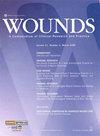COVID-19 防护面具造成外耳部分横断。
IF 1.4
4区 医学
Q3 DERMATOLOGY
Wounds : a compendium of clinical research and practice
Pub Date : 2023-10-01
DOI:10.25270/wnds/23070
引用次数: 0
摘要
引言 在 COVID-19 大流行期间,戴外科口罩作为一种预防感染的手段被广泛采用,但也有一些关于口罩引发皮肤问题的报道。在本报告中,我们描述了一例因戴口罩导致耳朵受伤而需要进行手术的病例。 病例报告 一位原本健康的 63 岁男性因耳廓受伤来到整形外科就诊。一个多月来,他一直戴着一个对他的脸来说太小的口罩;紧绷的耳环导致他的左耳廓上部开始剥离,造成大面积撕裂。左侧耳廓上部有三分之一以上撕裂,伤口表面上皮化。患者没有皮肤病或精神病史,但从事的工作需要经常戴头盔。手术对上皮化的伤口表面进行了修整和缝合,患者痊愈后未出现并发症。 结论 虽然自大流行病高峰期以来,佩戴口罩的规定和建议已大大放宽,但本文作者的经历揭示了与口罩使用有关的问题。因此,应努力调查这些问题的原因并提供适当的建议。本文章由计算机程序翻译,如有差异,请以英文原文为准。
Partial transection of the external ear caused by a mask worn for COVID-19 protection.
INTRODUCTION During the COVID-19 pandemic surgical mask-wearing was widely adopted as a means of preventing infections, but there have been several reports of mask-induced skin problems. In this report, we describe a case in which surgery was required for a mask-induced ear injury. CASE REPORT An otherwise healthy 63-year-old male presented to the plastic surgery department with an auricle injury. He had been using a mask that was too small for his face for more than 1 month; the tight ear loops caused the upper part of his left auricle to begin to dissect, resulting in a large tear. More than a third of the left upper auricle was torn, and the wound surface was epithelialized. The patient had no history of skin disease or psychiatric disorder but was engaged in a job that required wearing a helmet constantly. Surgery was performed to refresh the epithelialized wound surface and suture it, and the patient healed without complication. CONCLUSION While mask-wearing mandates and recommendations have considerably eased since the height of the pandemic, the current authors' experience has brought to light problems related to mask usage. Thus, efforts should be made to investigate the causes of these problems and provide appropriate advice.
求助全文
通过发布文献求助,成功后即可免费获取论文全文。
去求助
来源期刊
CiteScore
1.50
自引率
11.80%
发文量
77
审稿时长
6-12 weeks
期刊介绍:
Wounds is the most widely read, peer-reviewed journal focusing on wound care and wound research. The information disseminated to our readers includes valuable research and commentaries on tissue repair and regeneration, biology and biochemistry of wound healing, and clinical management of various wound etiologies.
Our multidisciplinary readership consists of dermatologists, general surgeons, plastic surgeons, vascular surgeons, internal medicine/family practitioners, podiatrists, gerontologists, researchers in industry or academia (PhDs), orthopedic surgeons, infectious disease physicians, nurse practitioners, and physician assistants. These practitioners must be well equipped to deal with a myriad of chronic wound conditions affecting their patients including vascular disease, diabetes, obesity, dermatological disorders, and more.
Whether dealing with a traumatic wound, a surgical or non-skin wound, a burn injury, or a diabetic foot ulcer, wound care professionals turn to Wounds for the latest in research and practice in this ever-growing field of medicine.

 求助内容:
求助内容: 应助结果提醒方式:
应助结果提醒方式:


